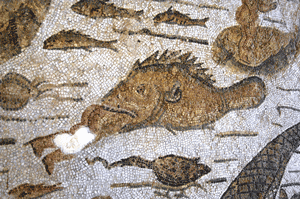
(Egidio Trainito)
Fish in the Mediterranean aren't what they used to be. Commercial and recreational fishing have decreased population sizes and also made individuals smaller, since big fish are kept and smaller ones thrown back. To determine whether protected, no-catch areas boost fish size and density, scientists from the University of Salento in Lecce, Italy, and Stanford University have to understand what fish populations were like in the past. They found a key source in classical mosaics (along with bones and paintings), many of which are detailed enough to identify fish, such as the dusky grouper, by species. Some mosaics depicting these groupers show them being fished from shallow water, whereas today they are found deeper. Other depictions, such as this one from the Bardo Museum in Tunis, indicate that the fish were much, much larger—big enough to swallow a fisherman whole. It may be an exaggeration, but it certainly depicts an animal much bigger than today's two-foot-long average. The scientists have found bigger groupers in protected areas, but populations outside the no-catch zones aren't recovering in the same way. Are the days of man-sized groupers in shallow waters gone forever? According to Paolo Guidetti of Salento, "My impression and experience is that if we give nature a chance to recover, nature does!"

